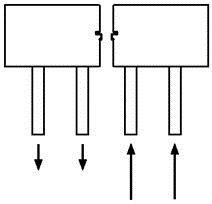Designing Pile Caps for Pile Capacity
When the user has selected to design pile caps based on the capacity of the supporting piles, the design is conducted in the same general manner as when designing for true pile loads, with the exceptions discussed below.
In applying the user specified pile capacities to the pile cap as a load, a factor is used that acts to convert the pile capacity to an ultimate level load. This factor is calculated on a column by column basis by taking the largest single value of (Pu/Pt) for all concrete load combinations, where Pu is the factored load in the column for a given concrete load combination, and Pt is the equivalent load using factors of 1.0 for each load case. The factor will not be taken greater than the largest individual load factor within a given load combination.
For the flexural design of the pile cap in particular, in applying the pile capacities to the pile caps as loads, a decision must be made whether to consider the compressive capacity or the tensile capacity of the piles. For a given group of piles on one side of the supported column generating moment at the column face, the actual pile loads for each load combination are investigated. If the actual pile loads create a net positive moment at the column face (tension at bottom of footing), the compressive capacity of the piles are applied as an upward force to the pile cap. If the actual pile loads create a net negative moment at the column face (tension at top of footing), the tensile capacity of the piles are applied as a downward force to the pile cap (see Figures below).
The design of pile caps for one-way and two-way shear is done considering the pile compressive capacity, regardless of the actual pile loads.


